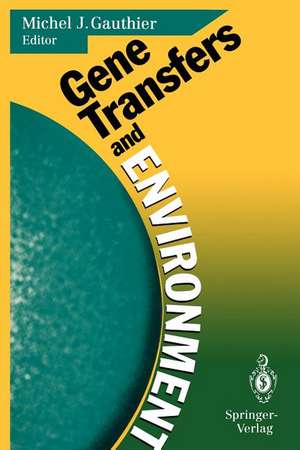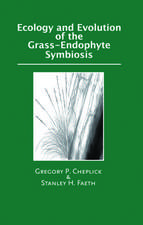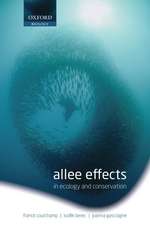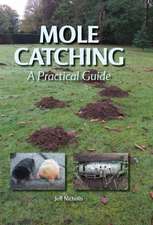Gene Transfers and Environment: Proceedings of the Third European Meeting on Bacterial Genetics and Ecology (BAGECO-3), 20–22 November 1991, Villefranche-sur-Mer, France
Editat de Michel J. Gauthieren Limba Engleză Paperback – 20 dec 2011
Preț: 636.80 lei
Preț vechi: 749.19 lei
-15% Nou
Puncte Express: 955
Preț estimativ în valută:
121.85€ • 132.77$ • 102.68£
121.85€ • 132.77$ • 102.68£
Carte tipărită la comandă
Livrare economică 23 aprilie-07 mai
Preluare comenzi: 021 569.72.76
Specificații
ISBN-13: 9783642774522
ISBN-10: 3642774520
Pagini: 220
Ilustrații: XI, 205 p.
Dimensiuni: 155 x 235 x 12 mm
Greutate: 0.32 kg
Ediția:Softcover reprint of the original 1st ed. 1992
Editura: Springer Berlin, Heidelberg
Colecția Springer
Locul publicării:Berlin, Heidelberg, Germany
ISBN-10: 3642774520
Pagini: 220
Ilustrații: XI, 205 p.
Dimensiuni: 155 x 235 x 12 mm
Greutate: 0.32 kg
Ediția:Softcover reprint of the original 1st ed. 1992
Editura: Springer Berlin, Heidelberg
Colecția Springer
Locul publicării:Berlin, Heidelberg, Germany
Public țintă
ResearchDescriere
Provided here is an up-to-date survey of gene transfers inthe main natural habitats, with a special reference togenetically engineered microorganisms.In the first of fivesections technical approaches of gene transfer in thenatural environment are developed. These emphasize the useof modernmethodologies for the detection of recombinantbacteria in natural waters and soil, using DNA or rRNAprobes and PCR technology. The three following sections dealwith various aspects of gene transfer in aquaticenvironments, terrestrial habitats and human and animal gut.These include transfer of plasmidic or chromosomal markersthrough either conjugation, mobilization, transformation ortransduction processes. Also covered are factors influencingsurvival of cells harbouring the transferred genes in theseenvironments. The last section is devoted to an examinationof scientific and ethical problems related to the release ofgenetically engineered microorganisms.
Cuprins
Section 1. Technical Approaches of Gene Transfer in Natural Environments.- - Direct Detection of Particular DNA Sequences in Soil.- - Autotrophic Ammonia-Oxidizing Bacteria in Stratified Eutrophic Lakes: Development of Ribosomal RNA-Directed Oligonucleotide Probes.- - The Detection of Marked Populations of Recombinant Pseudomonads Released into Lake Water.- - Screening of Erythromycin Resistant Bacillus spp. from Aerobiological Samplings for Recombinant DNA.- - Stress and Survival in Alcaligenes eutrophus CH34: Effects of Temperature and Genetic Rearrangements.- Section 2. Aquatic Environments.- - Effect of Host Cell Physiology on Plasmid Transfer in River Epilithon.- - Virus-Mediated Gene Transfer in Freshwater Environments.- - Intergeneric Natural Plasmid Transformation between Escherichia coli and a Marine Vibrio Species.- - Natural Transformation on Agar and in River Epilithon.- Section 3. Soil and Terrestrial Environments.- - Conjugal Gene Transfer in the Soil Environment; New Approaches and Developments.- - Gene Transfer via Transformation in Soil/Sediment Environments.- - DNA Binding to Various Clay Minerals and Retarded Enzymatic Degradation of DNA in a Sand/Clay Microcosm.- - Characterization of Natural Transformation of the Soil Bacteria Pseudomonas stutzeri and Acinetobactercalcoaceticus by Chromosomal and Plasmid DNA.- - The Importance of Retromobilization to Gene Dissemination and the Effect of Heavy Metal Pollution on Retromobilization in Soil.- - Interactions between Actinophage and their Streptomycete Hosts in Soil and the Fate of Phage Borne Genes.- - Assessment of the Potential for Gene Transfer in the Phytosphere of Sugar Beet.- Section 4. Human and Animal Gut.- - Gene Transfer in Human and Animals Gut.- - Conjugal Transfer of Genetic Information in Gnotobiotic Mice.- - In vivo Transfer of a Conjugative Plasmid between Isogenic Escherichia coli Strains in the Gut of Chickens, in the Presence and Absence of Selective Pressure.- - Origin and Spread of Penicillin-Resistance in Neisseria meningitidis.- Section 5. Genetically Engineered Microorganisms.- - Release of Genetically Modified Microorganisms in Natural Environments: Scientific and Ethical Problems.- - Development of Sensitive Techniques Based on DNA Probes and PCR-Amplification, for the Study of the Survival and Genetic Stability of Lactococcus spp. in the Environment and the Gastrointestinal Tract.
















